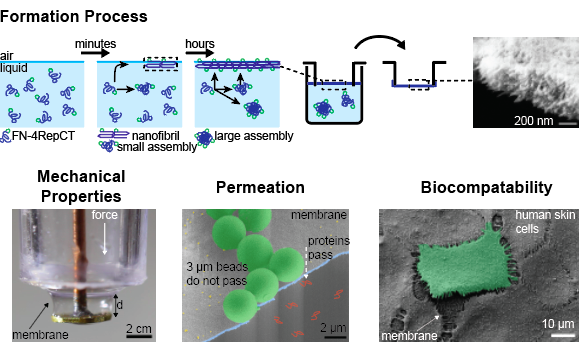Spider Silk Membranes
Spider silk is a fascinating material which has been used by humans since ancient times for a wide range of applications ranging from sutures to fishing gear. Details about challenges associated with farming spiders and constructing nanostructures out of spider silk membranes under biologically compatible conditions are introduced in our related work here.
In this work we focus on the fabrication, handling, and characterization of spider silk nanomembranes formed by over-night self-assembly at the liquid air interface. The slow, unforced process allows the spider silk proteins to form nanofibrils, generating a fibrillar membrane. By forming the membrane within a holder, it can easily be transferred and further characterized. Using both a rigid indenter as well as a characteristic bulging set-up the membrane is shown to be ultra-strong, elastic, and highly flexible. It is possible to stretch the membrane over 220%. In addition, the membrane is shown to be permeable to both small molecules as well as proteins, opening up for the possibility of inter-cell communication between cells cultured on opposite sides of the membrane. In the end, human skin cells are grown on the membrane, establishing a confluent layer within three days, opening up for applications within tissue engineering. For example, it would be possible to culture cells in-vitro to produce dermal transplants.

------------------------------------------------------------------------------------------------------------
Project Members:
Linnea Gustafsson, Christos Panagiotis Tasiopoulos, Ronnie Jansson, Mathias Kvick, Thijs Duursma, Thomas Christian Gasser, My Hedhammar, and Prof. Wouter van der Wijngaart
Publications related to this project:
Upcoming publications related to this project:
Mechanical Charcterization of Spider Silk Nanomembranes - MicroTas 2020
Project Sponsors: